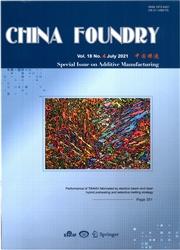Corrosion and wear properties of in situ (TiB+TiC)/TA15 composites with a high volume percentage of reinforcement
IF 2.3
3区 材料科学
Q2 Materials Science
引用次数: 0
Abstract
The in situ (TiC+TiB)/TA15 composites with different volume percentages of reinforcement (10%, 15%, 20% and 25%) were prepared by water-cooled copper crucible vacuum suspension melting technology. The structures and compositions of the TA15 alloy and its composites were analyzed by XRD and EDS, and their electrochemical corrosion behavior in the 3.5% NaCl solution was studied. Corrosion wear testing was conducted using a reciprocating ball-on-disc wear tester under a 10 N load. Results show that the in situ fibrous TiB phase and the granular TiC phase are uniformly distributed on the composite matrix. The microhardness can reach up to 531 HV as 10vol.% TiC+TiB reinforcement is added. Compared with the TA15 alloy, the volume wear rate decreases from (2.21±0.07)×10−4 to (1.75±0.07)×10−4 mm3·N−1·m−1 by adding 15vol.% TiC+TiB reinforcement, and the wear mechanism is adhesive wear. When the volume percentage of the reinforcement phase reaches 25%, the volume wear rate increases from (1.75±0.07)×10−4 to (2.41±0.07)·10−4 mm3·N−1·m−1, and the wear mechanism changes into abrasive wear. The volume loss resulted by the interaction between corrosion and wear accounts for more than 27% of the total wear volume. The volume loss due to wear-induced corrosion changes from 1.94% to 4.06% with different addition of reinforcement. The volume loss caused by corrosion-induced wear initially increases from 24.08% to 26.90% as the reinforcement increases from 0 to 15% due to the increase of corrosion potential, and then decreases from 26.90% to 25.68% as the reinforcement increases from 15% to 25% due to the peeling of TiC phase.高体积百分比增强的原位(TiB+TiC)/TA15复合材料的腐蚀磨损性能
采用水冷铜坩埚真空悬浮熔炼技术制备了不同体积增强率(10%、15%、20%和25%)的原位(TiC+TiB)/TA15复合材料。采用XRD和EDS分析了TA15合金及其复合材料的结构和成分,并研究了其在3.5% NaCl溶液中的电化学腐蚀行为。在10 N载荷下,使用往复式球盘式磨损试验机进行腐蚀磨损测试。结果表明:原位纤维状TiB相和颗粒状TiC相在复合基体上均匀分布;10vol时显微硬度可达531 HV。添加了% TiC+TiB增强。与TA15合金相比,加入15vol后,体积磨损率由(2.21±0.07)×10−4降低至(1.75±0.07)×10−4 mm3·N−1·m−1。% TiC+TiB增强,磨损机制为粘着磨损。当增强相体积百分比达到25%时,体积磨损率由(1.75±0.07)×10−4增加到(2.41±0.07)·10−4 mm3·N−1·m−1,磨损机制转变为磨粒磨损。腐蚀和磨损相互作用造成的体积损失占总磨损体积的27%以上。添加不同的补强剂,磨损腐蚀的体积损失从1.94%增加到4.06%。由于腐蚀电位的增加,当增强量从0增加到15%时,腐蚀磨损引起的体积损失从24.08%增加到26.90%,当增强量从15%增加到25%时,由于TiC相的剥落,腐蚀磨损引起的体积损失从26.90%降低到25.68%。
本文章由计算机程序翻译,如有差异,请以英文原文为准。
求助全文
约1分钟内获得全文
求助全文
来源期刊

China Foundry
工程技术-冶金工程
CiteScore
2.10
自引率
25.00%
发文量
1646
审稿时长
3.0 months
期刊介绍:
China Foundry, published bimonthly to a worldwide readership, mainly reports on advanced scientific and technical achievements, applied technology, production successes, management and leadership, recent developments and industry information in the foundry field. Coverage encompasses all casting technologies and includes, but is not limited to, novel and net shape casting technologies; casting alloy design and modification; control of nucleation, solidification and microstructure & mechanical properties; computer aided design; rapid prototyping; mold making, mold materials and binders; mold and gating design; melting and liquid-metal treatment and transport; modeling and simulation of metal flow and solidification; post-casting treatments; quality control and non-destructive testing; process automation and robotics; and safety and environmental issues.
 求助内容:
求助内容: 应助结果提醒方式:
应助结果提醒方式:


